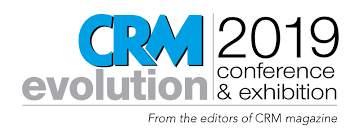
by twieberneit | May 3, 2019 | Analysis, Blog |
CRM evolution 2019 just ended. It has again been a highly interesting two and a half days filled with interesting presentations and discussions. A big thank you go to the organizers and the chairs. It has also been the first time that the venerable Brent Leary chaired it, stepping into the big footprint that Paul Greenberg has left. Unsurprisingly, Brent did very well. Of course, Paul, being Paul, was still there as a speaker with an engaging presentation, concentrating on what he calls the commonwealth of self-interest, on how to be highly successful because of applying an outside-in view. CRM evolution is part of a group event of related conferences that all happen at the same time. This year, in addition to Smart Customer Service and Speechtek, there was a dedicated event focusing on DigitalExperience. This acknowledges how important this topic, that actually touches all the other topics, has become in the past years. It also raises the question again why these four events are marketed as different events. With the possible exception of Speechtek all topics are related enough to be warranted as facets of the same. And they are, in my eyes. I do not know, how the chairs do it, but they continue to attract a number of high caliber speakers, starting off with Jarno Duursma as the main keynoter of day one, followed by a very knowledgeable Barton Goldenberg on day two. While Jarno focused on AI, which is arguably the most exciting topic these days, Barton showcased how to actually get CX profitably done using a community scenario. This breadth explains a good part...

by twieberneit | Mar 20, 2019 | Analysis, Blog |
The News Today Salesforce announced the next release of its Service Cloud. It brings together more Einstein AI as part of the Service Cloud and adds Quip to it. This enables more agent empowerment and efficient work. In order to augment the tools with the necessary knowledge and soft skills, Salesforce also just launched Trailblazers for the Future, a program that is targeted towards increasing the soft skills of service managers and service agents. Einstein now is delivering reply suggestions as well as article suggestions to inquiries that the service representative can easily use to reply to questions. At the same time Einstein suggests so called next best actions that are designed to help increase satisfaction and unearth cross- and upsell opportunities. Additionally, Einstein now optimizes case routing leveraging machine-learning processes on the inquiry to find the ideal queue for processing it. Additionally, Salesforce embedded the collaboration tool Quip into the Service Cloud to increase productivity and to increase service agents’ access to knowledge. The press release is here but for your convenience you can read it below. The Press Release Salesforce Empowers Service Agents with Einstein AI and Quip for Service Service Cloud expands Einstein AI portfolio with new intelligent recommendation and routing capabilities so agents can spend more time where it matters most — building customer relationships and solving complex problems New Quip for Service boosts agent productivity with incident swarming and cross-team collaboration available directly in the agent console SAN FRANCISCO—March 19, 2019—Salesforce [NYSE: CRM], the global leader in CRM, today announced new artificial intelligence and productivity solutions that empower customer service agents...

by twieberneit | Jan 28, 2019 | Analysis, Blog |
AI, IoT, and CRM, three acronyms. However, these three belong together and should not be treated or looked at separately. One important reason for this is that companies and organizations can provide significantly better service experiences and, more importantly, results, by combining the capabilities behind these acronyms. Good field service not only gets dispatched smartly but also equipped with the right parts and, ideally, in a proactive manner. This can get delivered by the combination of Field Service, AI, and IoT data. That’s why I found Salesforce’s early December announcement of having added a component “IoT insights” to its Field Service Lightning product quite interesting. As the press release said, this capability enables service agents and representatives to see IoT signals together with other CRM data, so that the triple p of personalized, proactive, even predictive service is possible. After all, Einstein is embedded into Field Service Lightning for quite some time now. Doing so, Salesforce wisely did not implement yet another IoT platform but enabled its system to ingest data from existing IoT platforms, thus sticking to the core competencies of the company. The solution helps in three areas: Enabling of early issue anticipation (rather than detection, which is responsive) and remote diagnosis Providing agents with more relevant information, to speed up issue resolution And automation via rules and workflows. Says Paolo Bergamo, SVP and GM, Salesforce Field Service Lightning: Let me first clarify that we’re not competing with IoT platforms from the likes of AWS IoT or Azure IoT. Our solution extends the value of these platforms – they provide streams of device data that then flow...

by twieberneit | Nov 25, 2018 | Blog |
Back in 2015 the Washington D.C. Office of Unified Communications (OUC) started a re-platforming exercise of their backbone from an on premise system to a cloud based customer service solution. The Washington, D.C. Office of Unified Communications manages non-emergency services for 311 callers across the District of Columbia, supporting 17 different agencies, including the Department of Transportation, the Department of Public Works, the Department of Motor Vehicles, and more. The OUC also manages emergency services for 911 callers. One of the main reasons for this re-platforming was the downtime challenge inherent to all on premise platforms: They need to be upgraded regularly, which causes service degradation or even unavailability. Other reasons included insufficient and slow reporting capabilities as well as the need to add more self-service channels. Having strong reporting and analytics capabilities are crucially important for call centers. The biggest thing for them is the answer and solution rate, which needs to be as high as possible. Additional self-service channels were necessary to be able to cope with the influx of requests and to both, improve customer satisfaction and modernize the customer experience. To further achieve the latter, a chat service and social media channels like Facebook, Instagram and Twitter have been added to the 311 services. All of these challenges have been addressed by migrating to a software solution based upon the Salesforce Service Cloud, along with some organizational measures. Being a main KPI, the answer wait time has been drastically reduced from 7 minutes to a mere 31 seconds. Doesn’t sound good to you? Consider that the service still serves 1.8 million calls per year with...

by twieberneit | Jul 23, 2018 | Analysis, Blog |
The News A few days ago Salesforce released a new iteration of its Service Cloud Einstein after infusing its artificial intelligence, Einstein, into the Service Cloud in February 2017. This release comes with three major enhancements to the Service Cloud: Einstein Bots for Service Lightning Flow for Service Einstein Next Best Action Einstein Bots for Service is providing the ability to easily configure chat bots that enable instant response to customers and a seamless handoff to customer service agents. Lightning Flow for Service gives companies the ability to automate processes with contextual, step-by-step guidance for fulfilling requests and resolving issues, using a graphical interface. Einstein Next Best Action is delivering intelligent recommendations and offers on any channel to increase customer satisfaction. While Einstein Bots for Service and Lightning Flow for Service are in General Availability since July 11, 2018, Einstein Next Best Actions will remain in a Pilot phase for some more time. The reason for this is that Salesforce wants to be double sure that this functionality is reliable. It needs a good amount of data and a good training set. And Salesforce cannot look into the data. The bots themselves do need to get trained and, once active, take feedback from the service agents. All three features work hand-in-hand. Salesforce uses a credit card scenario to make this point. When a customer goes to the web site for help the chat bot takes over and gathers the necessary contextual information and then escalates the issue to a customer service agent who continues the chat at the position the chat bot exited with all information available. A Lightning...






